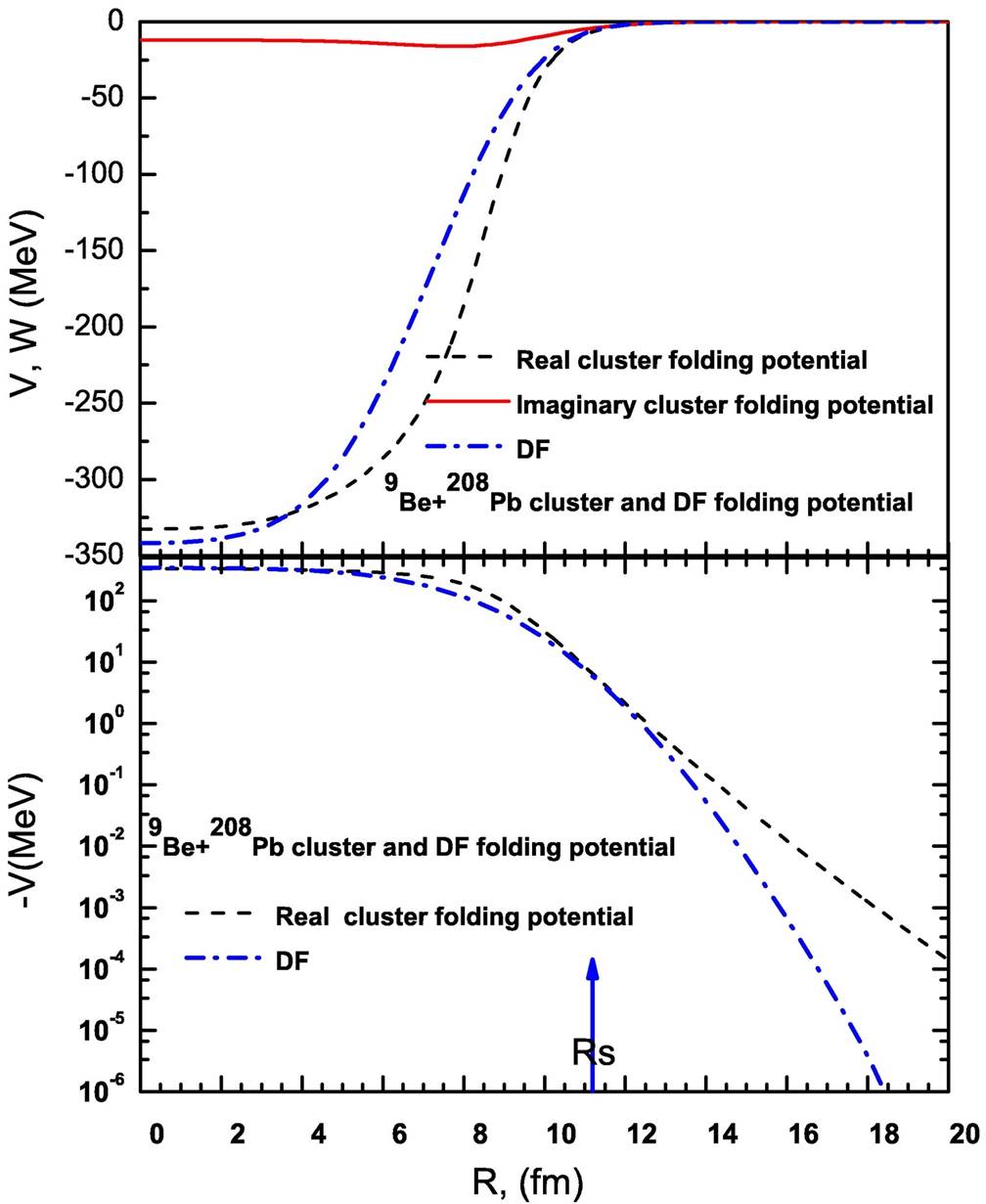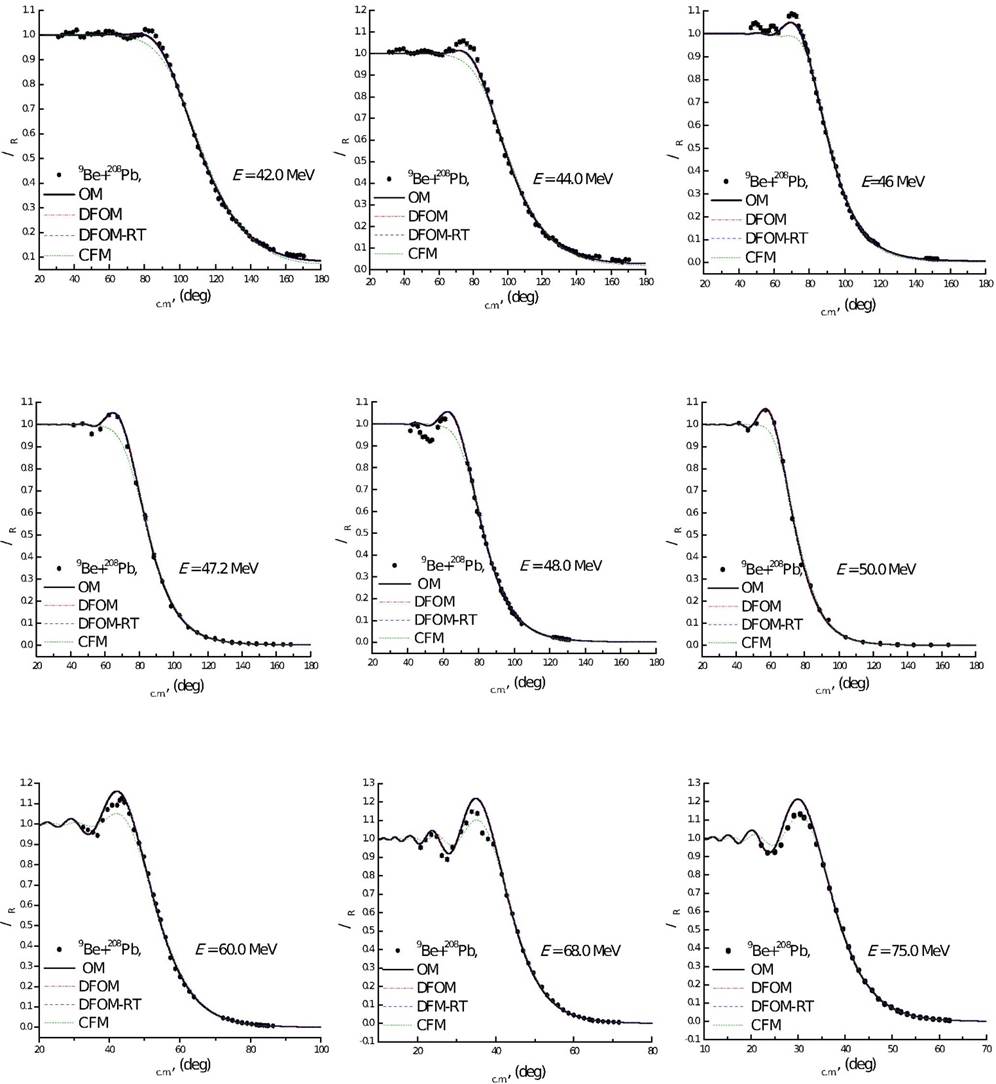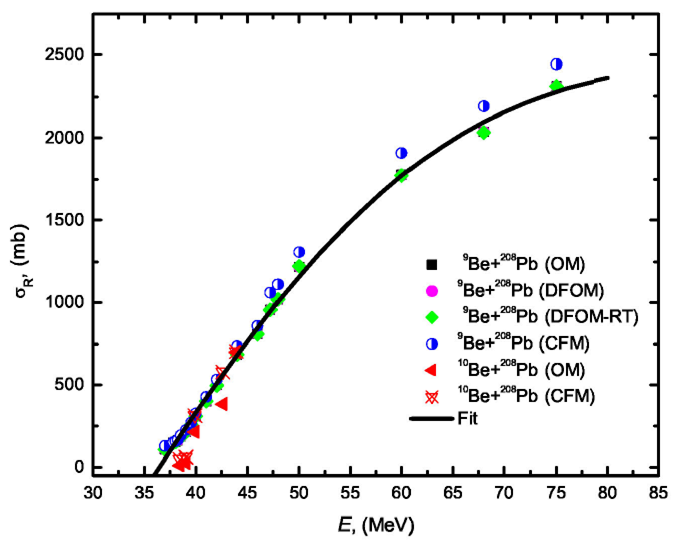1. Introduction
Recently, with the increasing possibility and availability of accelerating different radioactive beams, many nuclear processes induced by different weakly bound nuclei have become a hot topic of research. Due to the weak binding for these nuclei, the coupling effect to break-up channels is expected to increase. The break-up effect observed in 6Li and 7Li projectiles for example, is found to play a key role in exhibiting some abnormalities such as the necessity to reduce the strength of double folding (DF) potential by about 30-50 % in order to reproduce the experimental data. The same situation was also reported while using cluster folding potential in reproducing the experimental data for nuclear systems induced by 6,7Li ion beams1-8. Other interesting weakly bound nuclei are the 9,10Be isotopes which are subjected to a detailed analysis in current work in order to probe their interaction mechanism with the heavy 208Pb target9-12.
However, 9Be is another anomalous projectile that requires significantly less renormalization than unity. In the tail region of 6,7Li, the imaginary potential is diffuse and stronger than the real potential. 9Be, like 6,7Li, is loosely bound, breaking up into n + 2a with only 1.57 MeV. The odd neutron in 9Be is only bound by 1.367 MeV, and Satchler has shown that the potential depth near the strong absorption radius is strongly influenced by the neutron density treatment13-16.
Elastic scattering processes between two colliding nuclei still remain an important topic in nuclear physics studies. The angular distributions of elastic scattering cross sections can exhibit different features depending on the structure of the two colliding nuclei and on the projectile’s energy. For stable projectiles, and at energies close to the Coulomb barrier, Fresnel oscillatory diffraction pattern may appear when the angular distributions are plotted as a ratio to Rutherford cross sections. This Fresnel peak, usually called Coulomb rainbow, is due to the interference between partial waves refracted by the Coulomb and short-range nuclear potentials. For light projectiles, the Coulomb force becomes smaller and the diffractive pattern changes from Fresnel to Fraunhofer oscillations at higher energies. The data from our previous study17 of the interaction mechanism of weakly bound 9,10,11Be scattered from 64Zn were analyzed using both the conventional optical model (OM) and the double folding optical model (DFOM). The elastic scattering angular distributions for 9,10Be isotopes are well reproduced both by the phenomenological OM as well as the DFOM with the suitable optimized parameter sets, while for the 11Be isotope, the strong reduction of the cross section around the nuclear-Coulomb interference angles can not be reproduced by the DFOM. The reasonable fit to the data is only achieved by adding a very long-range absorption term in the imaginary part. The differences in the extracted renormalization factor (Nr) values for the different considered nuclear systems induced by Be isotopes could reflect the difference of weak binding nature among the three studied Be isotopes.
In this paper, both pure phenomenological and semi-microscopic potentials are used to investigate the interaction mechanism for the weakly bound 9,10Be nuclei scattered from 208Pb target at various available energies. In connection with this aim, the following data are analyzed: 9Be+208Pb in the energy range 37.0 - 75.0 MeV9,11 and 10Be+208Pb in the energy range 38.4-43.9 MeV10,12.
The paper is organized as follows. Section 2 discusses the nuclear potentials that are used in the data analysis, while Sec. 3 discusses the results and discussion. The summary is provided in Sec. 4.
2. Theoretical methods
As a first step for probing the interaction mechanism for the considered nuclear systems, OM of the nucleus is applied. The implemented phenomenological OM potential has the following form:
The VC (r)is the Coulomb potential due to a uniform sphere with a charge equal to that of the target nucleus and radius rC At1/3. The nuclear potential is consisting from two parts: real volume (which simulate the scattering) and imaginary volume (simulate the reduction in flux due to absorption), both has the phenomenological Woods-Saxon (WS) shape.
In the semi-microscopic analysis, the real part of the potential was constructed based on the DF procedures as,
where ρp (r1), ρt
(r2) are the matter densities of the projectile and the target respectively and vNN (S) is the effective NN interaction between two nucleons where
For 10Be(208Pb), R = 2.0(6.80)fm,a = 0.511(0.515)fm and root-mean-square (rms) matter radius of 2.45 fm, respectively while ρ0 can be determined from the normalization condition.
The DF potential consists mainly of two parts.
The direct part is
and the knock-on exchange part in the infinite-range exchange is
In the present work, the modified version of CDM3Y6 interaction based on the inclusion of the rearrangement term (RT) is used, and is denoted by (CDM3Y6-RT). This effective interaction (CDM3Y6-RT) uses another density dependent version (CDM3Y6) of the M3Y effective NN interaction based on the G-matrix elements of Paris potential for the direct and exchange terms Eqs. (5) and (6). The full CDM3Y6 interaction form is defined as24,
where, the density dependent function F is written as25
and g(E) is the additional energy dependent factor written as24,
For the modified (CDM3Y6-RT) interaction with the inclusion of RT term, the term ΔF(ρ) is added in the folding model calculation, where ΔF(ρ) can be written as25,
2.1. Analysis of 9Be+208Pb
The 9Be+208Pb data in the energy range of 37.0-75.0 MeV is reanalyzed from the phenomenological point of view using OM. Then, this nuclear system is analyzed semi-microscopically using double folding optical model (DFOM). In this model, the real part of the potential was constructed by folding the density distributions of 9Be and 208Pb with nucleon- nucleon interaction potential of the M3Y form with and without taking into consideration the effect of rearrangement term, namely, DFOM and DFOM-RT, in addition to a phenomenological WS imaginary potential of parameters fixed to those obtained from OM analysis. Finally, the 9Be + 208Pb data in the aforementioned energy range is subjected to a fully microscopic analysis based on cluster folding model (CFM) for both real and imaginary parts. The cluster folding calculations were constructed based on the 7Li + d cluster structure of 9Be. The required ingredients to prepare the cluster folding potential for both the real and imaginary parts are: the 7Li + 208Pb and d + 208Pb potentials at appropriate energies as well as the 7Li + d binding potential. As the experimental data for 9Be + 208Pb elastic scattering angular distribution at Elab (9Be) = 75.0 MeV is the highest energy under consideration, the required potentials are: 7Li + 208Pb potential at Elab (7Li) = 7/9 x 75 = 58.3 MeV and the d + 208Pb potential at Elab (d) = 2/9 x 75 = 16.7 MeV. Fortunately, there are available experimental measurements for 7Li + 208Pb angular distribution at Elab = 63 MeV26 which is close to the required 58.3 MeV, and for d + 208Pb at Elab = 63 MeV27 which is close to the required 16.7 MeV. The real and imaginary cluster folding parts of the 9Be + 208Pb potential can be defined on the basis of 7Li + 208Pb and d + 208Pb potentials as follows:
where
2.2. Analysis of 10Be+208Pb
The available experimental angular distributions for 10Be+208Pb elastic scattering at energies Elab = 38.4, 39, 39.9, 42.6, and 43.9 MeV10 are reanalyzed from the phenomenological and the semi-microscopic point of view. Firstly, the OM analysis was performed utilizing OM potential consisting from real and imaginary volume parts, each having the conventional WS form in addition to a Coulomb part “see Eq. (1)”. The analysis was performed using fixed radii parameters. Then, on the basis of the 9Be + n cluster structure of 10Be, the considered data are reanalyzed using cluster folding model. The required ingredients to perform cluster folding calculations for 10Be + 208Pb by considering the proposed 9Be + n cluster structure of 10Be are: the 9Be + 208Pb potential at Elab (9Be) = 9/10 x Elab (10Be), n + 208Pb potential at Elab (n) = 1/10 x Elab(10Be) and n + 9Be binding potential. For 10Be + 208Pb elastic scattering angular distributions in the energy range 38.4 - 43.9 MeV, the highest energy under consideration is Elab (10Be) = 43.9 MeV. Fortunately there are available experimental measurements for 9Be + 208Pb angular distribution at Elab(9Be) = 39.6 MeV11. The real and imaginary cluster folding parts of the 10Be + 208Pb potential can be defined on the basis of 9Be + 208Pb and n+208Pb potentials as follows:
where
The generated cluster folding potential for 10Be+208Pb is shown in Fig. 2. To validate our analysis, we plotted expression (11) for 9Be+208Pb at 75 MeV and expression (13) for 10Be+208Pb at 48.3 MeV, respectively, against the DF potential with finite-range exchange contribution for the densities under consideration, as shown in Figs. 1 and 2. At (R=0), (VCluster (0)/VDF (0)) ≈ 0.95, this means that the scattering is sensitive to the real potential for both the considered systems. These two figures show that, the DF potential is about 5% deeper than the cluster potential at(R = 0), while they are similar for radial distances R ranging from 0.5 fm to 7 fm.
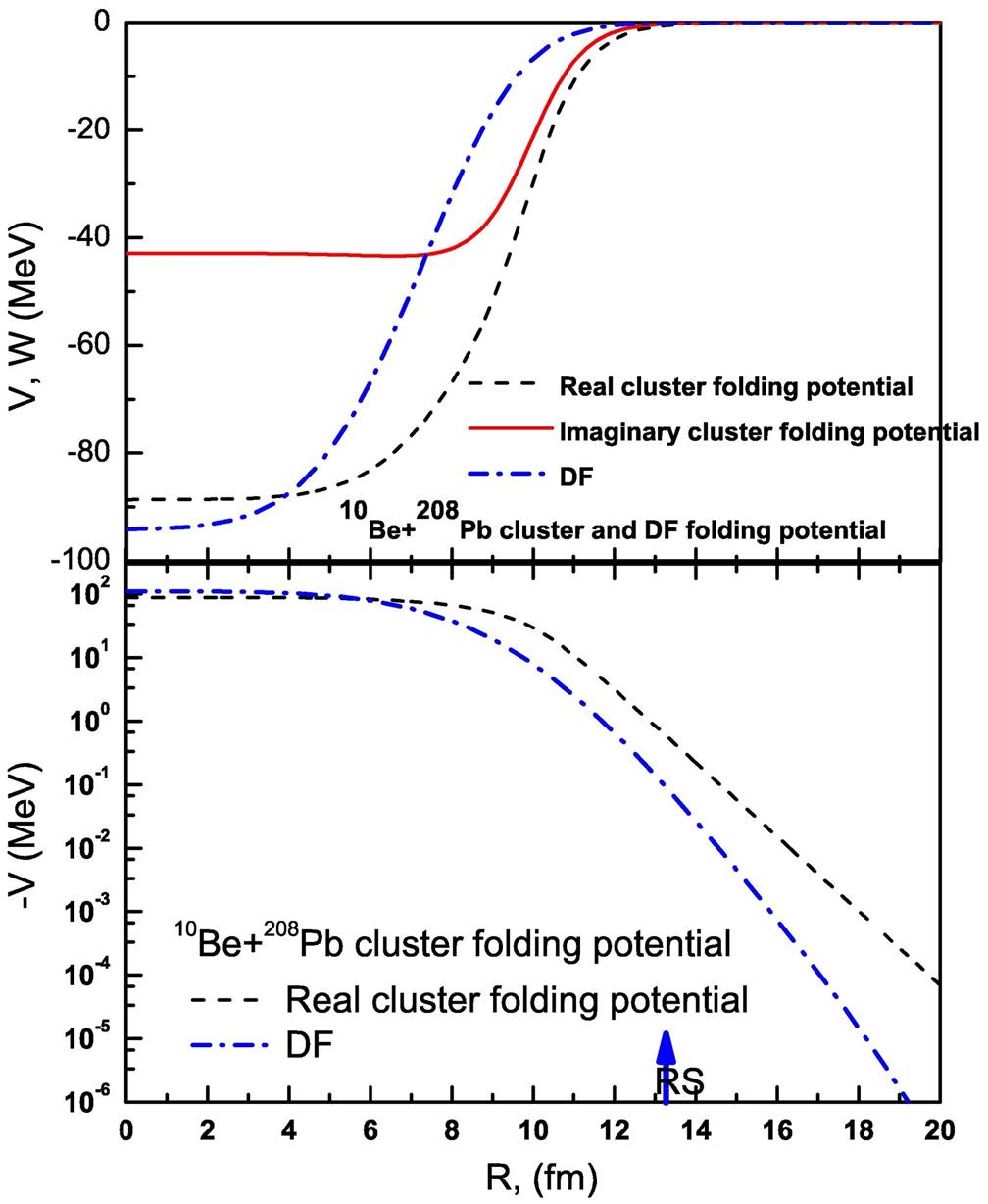
Figure 2 Real and imaginary parts of 10Be+208Pb cluster folding potential constructed on the 9Be + n cluster structure for 10Be.
A strong absorption radius RS (closest approach) through the surface radial region can be defined as the distance between colliding particles in terms of the transmission coefficient T1/2, which is a function of the partial wave and momentum L1/2, as well as the Sommerfield parameter η and the projectile wave number k13. We can see that the different DF and cluster potentials agree with each other near the strong absorption radius RS where RS =11.1 fm for the 9,10Be +208Pb reaction.
3. Results and discussion
3.1. 9 Be+208 Pb nuclear system
The comparison between the experimental 9Be+208Pb elastic scattering angular distributions in the energy range 37.0-75.0 MeV and the OM, DFOM, DFOM-RT, and CFM calculations performed using FRESCO code29 are shown in Figs. 3 and 4 using the potential parameters listed in Table I. In OM calculations, the analysis was performed using two adjustable parameters real and imaginary potential depths V0 and W0, while the real and imaginary radius and diffuseness parameters were kept fixed at 1.24 and 0.63 fm respectively. The potential parameters considered in Ref.11 for both the real and imaginary parts of potential were taken as starting parameters. It is clearly shown in Figs. 3 and 4, that the agreement between experimental data and OM calculations is fairly good even in the angular range where the Coulomb rainbow phenomenon is well presented. Although similar OM calculations were performed for 9Be+208Pb system in the energy range 37.0-50.011, it was necessary also in the current study to start our analysis from the pure phenomenological point of view in order to extract the optimal OM parameters for 9Be+208Pb system in the whole considered energy range. The optimal extracted imaginary potential parameters were implemented in the semi-microscopic analysis. In DFOM calculations, two approaches were used: DFOM and DFOM-RT in order to study the effect of introducing the rearrangement term. As expected, in order to describe 9Be+208Pb data, the strength of the real part should be reduced by (25-28%. The extracted average renormalization factor for the real part of the potential is 0.72±0.095 and 0.75±0.099 from DFOM and DFOM-RT calculations, respectively. The experimental data is reasonably reproduced by DFOM with nearly the same good fitting as shown in Figs. 3 and 4, whereas the DFOM-RT clearly provides a poorer description, particularly in the Coulomb rainbow region.
Table I Optimal potential parameters achieved from our best fifit to 9Be + 208Pb elastic scattering data in energy range Elab = 37.0 − 75.0 MeV using OM, DFOM, DFOM-RT, and CFM potentials.
| E | Model | V | Model | rV | aV | Nr | W | rW | aW | NRCF | X2/N | σR |
|---|---|---|---|---|---|---|---|---|---|---|---|---|
| 37 | OM | 29.44 | 1.24 | 0.63 | 58.0 | 1.24 | 0.63 | 7.5 | 107.4 | |||
| DFOM | 0.588 | 70.6 | 1.24 | 0.63 | 7.6 | 107.4 | ||||||
| DFOM- RT | 0.61 | 70.6 | 1.24 | 0.63 | 7.6 | 107.4 | ||||||
| CFM | 0.456 | 0.483 | 5.9 | 130.1 | ||||||||
| 37.8 | OM | 30.9 | 1.24 | 0.63 | 54.3 | 1.24 | 0.63 | 2.2 | 146.5 | |||
| DFOM | 0.604 | 54.3 | 1.24 | 0.63 | 2.1 | 146.5 | ||||||
| DFOM- RT | 0.627 | 54.3 | 1.24 | 0.63 | 2.1 | 146.5 | ||||||
| CFM | 0.734 | 0.390 | 1.7 | 152.7 | ||||||||
| 38 | OM | 36.1 | 1.24 | 0.63 | 50.0 | 1.24 | 0.63 | 3.5 | 152.9 | |||
| DFOM | 0.697 | 50.0 | 1.24 | 0.63 | 3.6 | 152.9 | ||||||
| DFOM- RT | 0.724 | 50.0 | 1.24 | 0.63 | 3.6 | 152.8 | ||||||
| CFM | 0.778 | 0.366 | 3.4 | 158.3 | ||||||||
| 38.2 | OM | 40.2 | 1.24 | 0.63 | 46.4 | 1.24 | 0.63 | 3.9 | 160.6 | |||
| DFOM | 0.768 | 46.4 | 1.24 | 0.63 | 4.1 | 160.5 | ||||||
| DFOM- RT | 0.798 | 46.4 | 1.24 | 0.63 | 4.1 | 160.5 | ||||||
| CFM | 0.785 | 0.356 | 4.5 | 167.4 | ||||||||
| 38.5 | OM | 42.6 | 1.24 | 0.63 | 45.7 | 1.24 | 0.63 | 3.8 | 182.3 | |||
| DFOM | 0.81 | 45.7 | 1.24 | 0.63 | 3.9 | 182.2 | ||||||
| DFOM- RT | 0.84 | 45.7 | 1.24 | 0.63 | 3.9 | 182.1 | ||||||
| CFM | 0.783 | 0.366 | 4.4 | 191.1 | ||||||||
| 39 | OM | 44.73 | 1.24 | 0.63 | 41.73 | 1.24 | 0.63 | 7.4 | 212.5 | |||
| DFOM | 0.84 | 41.73 | 1.24 | 0.63 | 8.0 | 212.3 | ||||||
| DFOM- RT | 0.872 | 41.73 | 1.24 | 0.63 | 8.0 | 212.2 | ||||||
| CFM | 0.766 | 0.358 | 10.5 | 223.2 | ||||||||
| 39.5 | OM | 43.07 | 1.24 | 0.63 | 42.86 | 1.24 | 0.63 | 4.6 | 256.7 | |||
| DFOM | 0.804 | 42.86 | 1.24 | 0.63 | 5.04 | 256.4 | ||||||
| DFOM- RT | 0.836 | 42.86 | 1.24 | 0.63 | 5.1 | 256.2 | ||||||
| CFM | 0.710 | 0.387 | 8.6 | 271.4 | ||||||||
| 40 | OM | 39.89 | 1.24 | 0.63 | 45.7 | 1.24 | 0.63 | 6.4 | 307.2 | |||
| DFOM | 0.741 | 45.7 | 1.24 | 0.63 | 7.0 | 306.7 | ||||||
| DFOM- RT | 0.772 | 45.7 | 1.24 | 0.63 | 7.0 | 306.6 | ||||||
| CFM | 0.640 | 0.425 | 13.0 | 325.1 | ||||||||
| 41 | OM | 36.02 | 1.24 | 0.63 | 47.07 | 1.24 | 0.63 | 7.04 | 401.9 | |||
| DFOM | 0.663 | 47.07 | 1.24 | 0.63 | 8.4 | 401.1 | ||||||
| DFOM- RT | 0.693 | 47.07 | 1.24 | 0.63 | 8.4 | 401.0 | ||||||
| CFM | 0.538 | 0.469 | 24.4 | 426.6 | ||||||||
| 42 | OM | 32.53 | 1.24 | 0.63 | 48.37 | 1.24 | 0.63 | 14.35 | 498.6 | |||
| DFOM | 0.596 | 48.37 | 1.24 | 0.63 | 15.9 | 497.9 | ||||||
| DFOM- RT | 0.624 | 48.37 | 1.24 | 0.63 | 15.9 | 497.7 | ||||||
| CFM | 0.447 | 0.512 | 43.2 | 531.8 | ||||||||
| 44 | OM | 30.97 | 1.24 | 0.63 | 47.41 | 1.24 | 0.63 | 6.2 | 684.8 | |||
| DFOM | 0.563 | 47.41 | 1.24 | 0.63 | 6.9 | 683.8 | ||||||
| DFOM- RT | 0.592 | 47.41 | 1.24 | 0.63 | 6.9 | 683.7 | ||||||
| CFM | 0.358 | 0.562 | 18.6 | 733.3 | ||||||||
| 46 | OM | 36.39 | 1.24 | 0.63 | 33.15 | 1.24 | 0.63 | 11.4 | 810.4 | |||
| DFOM | 0.662 | 33.15 | 1.24 | 0.63 | 13.9 | 809.9 | ||||||
| DFOM- RT | 0.696 | 33.15 | 1.24 | 0.63 | 14.2 | 809.2 | ||||||
| CFM | 0.459 | 0.44 | 40.0 | 857.1 | ||||||||
| 47.2 | OM | 38.16 | 1.24 | 0.63 | 41.17 | 1.24 | 0.63 | 10.2 | 957.1 | |||
| DFOM | 0.688 | 41.17 | 1.24 | 0.63 | 12.3 | 955.4 | ||||||
| DFOM- RT | 0.723 | 41.17 | 1.24 | 0.63 | 12.5 | 954.7 | ||||||
| CFM | 0.337 | 0.655 | 39.4 | 1060 | ||||||||
| 48 | OM | 36.09 | 1.24 | 0.63 | 42.11 | 1.24 | 0.63 | 19.2 | 1020 | |||
| DFOM | 0.661 | 42.11 | 1.24 | 0.63 | 18.7 | 1020 | ||||||
| DFOM- RT | 0.696 | 42.11 | 1.24 | 0.63 | 18.8 | 1020 | ||||||
| CFM | 0.348 | 0.628 | 28.2 | 1111 | ||||||||
| 50 | OM | 40.38 | 1.24 | 0.63 | 49.13 | 1.24 | 0.63 | 27.4 | 1217 | |||
| DFOM | 0.729 | 52.09 | 1.24 | 0.63 | 28.5 | 1215 | ||||||
| DFOM- RT | 0.766 | 52.2 | 1.24 | 0.63 | 28.7 | 1220 | ||||||
| CFM | 0.327 | 0.716 | 72.2 | 1307 | ||||||||
| 60 | OM | 46.5 | 1.24 | 0.63 | 38.27 | 1.24 | 0.63 | 14.1 | 1775 | |||
| DFOM | 0.846 | 38.27 | 1.24 | 0.63 | 16.1 | 1774 | ||||||
| DFOM- RT | 0.890 | 38.27 | 1.24 | 0.63 | 16.8 | 1772 | ||||||
| CFM | 0.418 | 0.703 | 39.6 | 1909 | ||||||||
| 68 | OM | 45.14 | 1.24 | 0.63 | 27.97 | 1.24 | 0.63 | 33.8 | 2039 | |||
| DFOM | 0.822 | 27.97 | 1.24 | 0.63 | 26.5 | 2037 | ||||||
| DFOM- RT | 0.864 | 27.97 | 1.24 | 0.63 | 26.2 | 2034 | ||||||
| CFM | 0.442 | 0.618 | 12.5 | 2196 | ||||||||
| 75 | OM | 45.49 | 1.24 | 0.63 | 33.67 | 1.24 | 0.63 | 20.7 | 2314 | |||
| DFOM | 0.844 | 33.67 | 1.24 | 0.63 | 17.3 | 2314 | ||||||
| DFOM- RT | 0.889 | 33.67 | 1.24 | 0.63 | 16.9 | 2312 | ||||||
| CFM | 0.453 | 0.645 | 5.1 | 2446 |
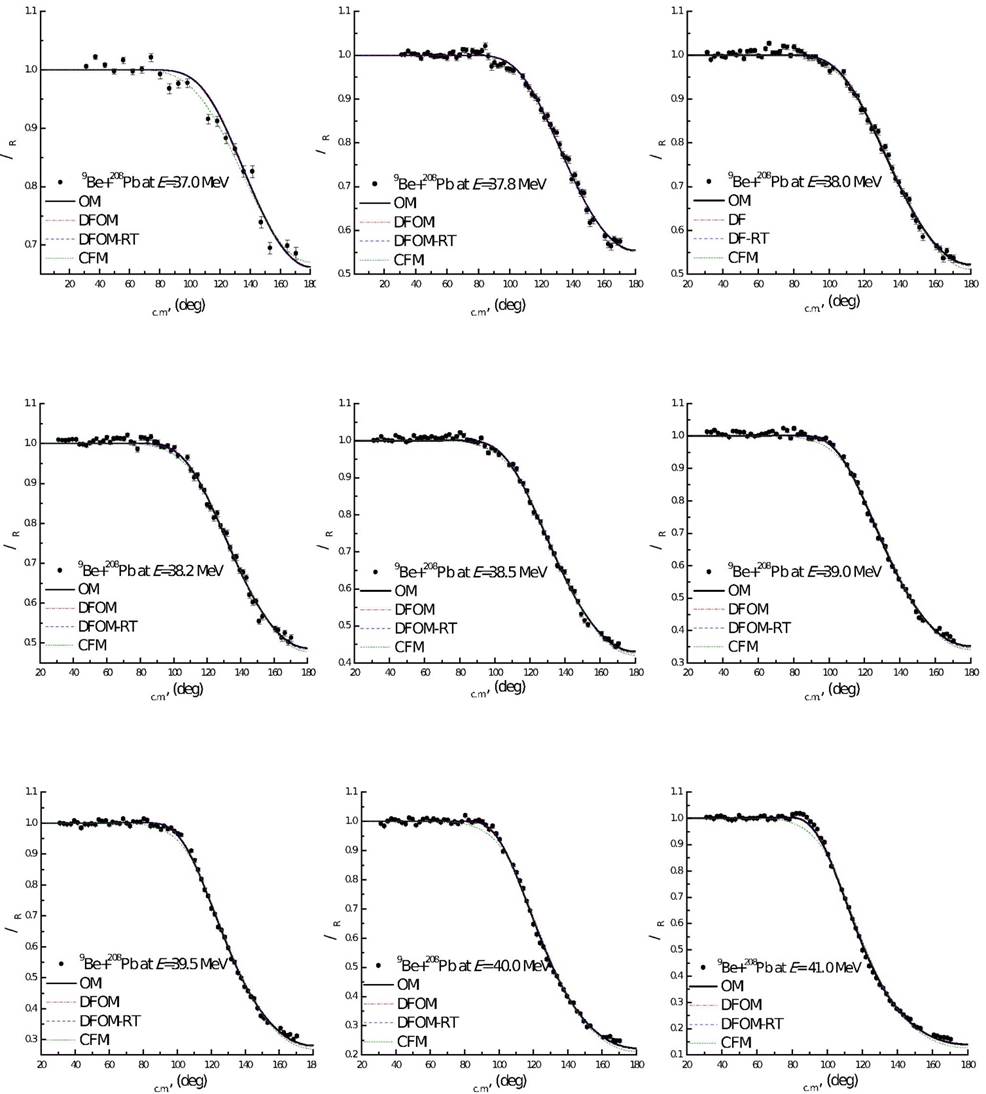
Figure 3 Comparison between 9Be+208Pb elastic scattering angular distributions at Elab = 37.0; 37.8; 38.0; 38.2; 38.5; 39.0; 39.5; 40.0, and 41.0 MeV and theoretical calculations using OM (solid lines), DFOM (dash dot lines), DFOM-RT (dash lines), and CFM (short dash lines).
Finally, the 9Be+208Pb elastic scattering angular distributions in the energy range 37.0-75.0 MeV are analyzed within the framework of CFM. The CFM analysis was performed using two free parameters NRCF and NIFC, namely renormalization factor for the real and imaginary cluster folding potential, respectively. These two parameters are allowed to be freely changed in the range 0.2-1.3 till reach the best agreement the experimental data and the theoretical calculations by minimizing the X2/N value. As shown in Figs. 3 and 4, the comparison between the experimental angular distributions for 9Be+208Pb nuclear system and theoretical calculations within the frame work of CFM is fairly good except in the angular range where Fresnel peak is presented especially at energies less than 60 MeV. At higher energies greater than 60 MeV, the CFM calculations reproduce well the Fresnel peak. In order to reproduce the experimental data using CFM, the strength of the real cluster folding parts should be reduced by (0.45%. The extracted average NRCF and NIFC values are 0.55(0.18 and 0.45(0.13, respectively. These results emphasize the weak nature of 9Be.
As shown in Fig. 5, the Coulomb rainbow phenomenon (Fresnel peak) which resulted from the interference between Coulomb and nuclear potential is well presented at energies above 40 MeV. It is obvious that with increasing the projectile energy, the position of Fresnel peak is shifted towards smaller angles.
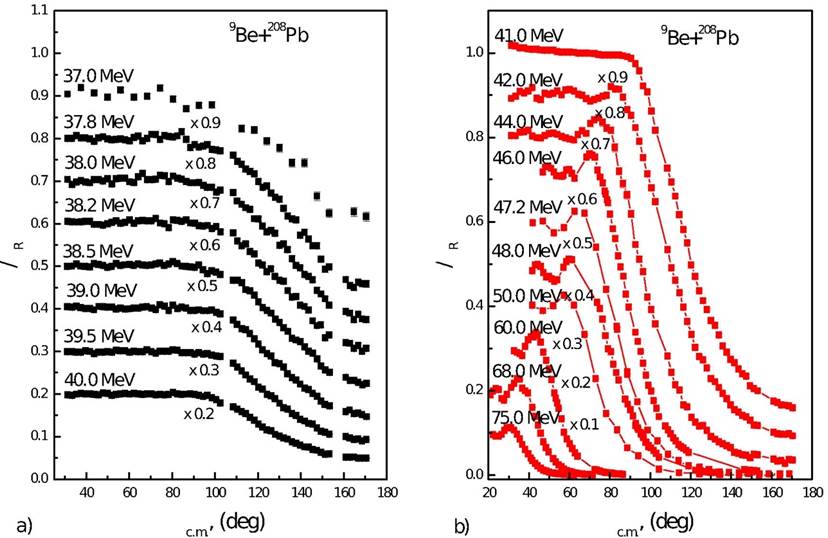
Figure 5 Angular distributions for 9Be+208Pb elastic scattering in the energy range 37.0-75.0 MeV. Data are displaced by 0.1 for the sake of clarity. Left panel for energies 37.0-4.0. MeV where Coulomb rainbow phenomenon is not observed. Right panel for energies 41.0- 75.0 MeV where Coulomb rainbow phenomenon is observed.
3.2. 9Be+208Pb nuclear system
The comparison between the experimental angular distributions for 10Be+208Pb nuclear system and theoretical calculations within the frame work of OM in the energy range 38.4 - 43.9 MeV is shown in Fig. 6. The OM calculations were performed by fixing radii parameters rV and rW to the values 1.355 and 1.338 fm, respectively and by allowing the other four parameters (real ands imaginary potential depth and diffuseness) to be changed freely till reach the best agreement between the experimental data and the theoretical calculations by minimizing the (2/N value as shown in Table II. The CFM analysis was performed using two free parameters NRCF and NICF. These two parameters are allowed to be freely changed in the range 0.2-1.2 till reach the best agreement between the experimental data and the theoretical calculations as shown in Fig. 6 using potential parameters listed in Table II. In order to reproduce the data within the frame work of CFM, the strength of real part of potential should be reduced by about 74 % which reflect the weak nature of 10Be.
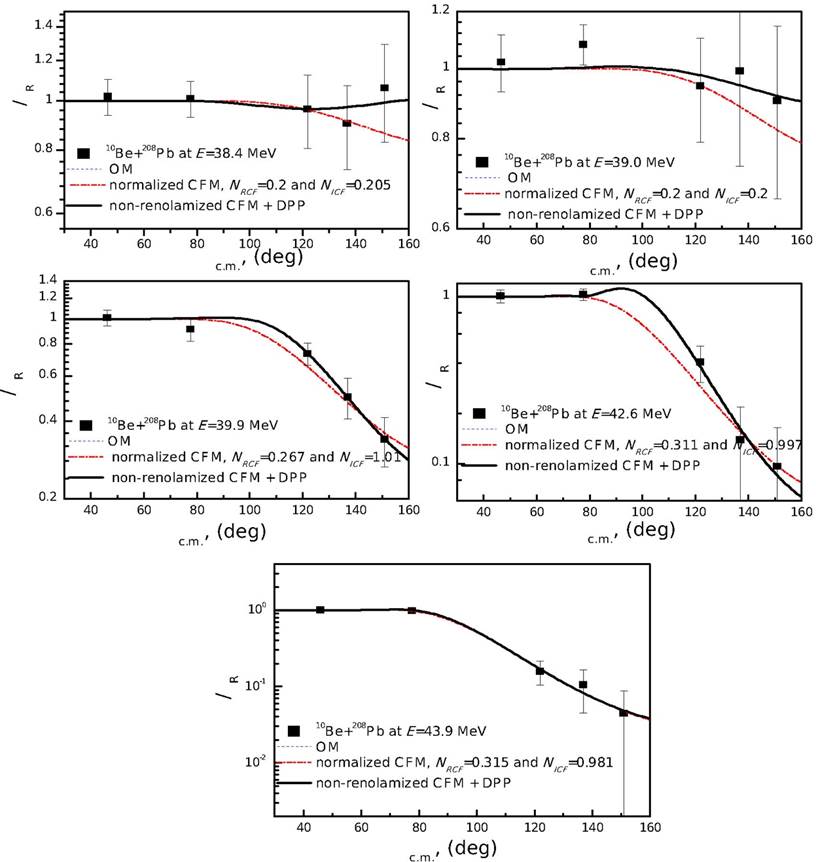
Figure 6 Comparison of elastic scattering angular distributions of 10Be+208Pb at Elab = 38.4, 39.0, 39.9, 42.6, and 43.9 MeV with theoretical calculations using OM, CFM, and CFM+DPP.
Table II Optimal potential parameters achieved from our best fit to the measured data of 10Be + 208Pb elastic scattering at Elab =38.4-43.9 MeV using OM with fixed rv= 1.355 and rw= 1.338 fm as well as CFM.
| E (MeV) | V | aV | W | aW | NRCF | NICF | χ2/N | σR | |
|---|---|---|---|---|---|---|---|---|---|
| 38.4 | OM | 25.0 | 0.25 | 33.79 | 0.25 | 0.37 | 11.67 | ||
| CFM | 0.2 | 0.205 | 0.7 | 45.15 | |||||
| 39.0 | OM | 25.0 | 0.25 | 29.96 | 0.264 | 0.19 | 21.57 | ||
| CFM | 0.2 | 0.2 | 0.5 | 57.9 | |||||
| 39.9 | OM | 25.0 | 0.49 | 28.6 | 0.413 | 0.19 | 211.7 | ||
| CFM | 0.267 | 1.01 | 0.55 | 310.9 | |||||
| 42.6 | OM | 25.0 | 0.452 | 25.0 | 0.32 | 1.06 | 379.7 | ||
| CFM | 0.311 | 0.997 | 1.98 | 577.4 | |||||
| 43.9 | OM | 25.0 | 0.405 | 25.0 | 0.543 | 1.12 | 700.1 | ||
| CFM | 0.315 | 0.981 | 1.12 | 700.7 |
Finally, 10Be+208Pb elastic scattering angular distributions in the aforementioned energy range are reanalyzed using the previously created cluster folding potential but without renormalizing the real and imaginary cluster potential parts (NRCF and NICF = 1) plus a dynamical polarization potential DPP in the form of Woods-Saxon and has a repulsive surface nature, namely CFM+DPP, to compensate the observed reduction in the strength of real and imaginary CF parts of potential. The dynamical polarization potential for both the real and imaginary parts has been fixed (rVpol = rWpol = 1.24 fm) and (aVpol = aWpol = 1.24 fm). Two parameters are allowed to be changed freely until they achieved the best agreement between data and calculations: real and imaginary dynamical polarization potential depths, Vpol and Wpol. The comparison between the experimental angular distributions for the 10Be+208Pb nuclear system and the CFM+DPP calculations is shown in Fig. 6 using the potential parameters listed in Table III.
Table III Optimal potential parameters achieved from our best fit to the measured data of 10Be + 208Pb elastic scattering at Elab=38.4-43.9 MeV using CFM of non-renormalized NRCF =1 and NICF =1 plus DPP, the approach CFM+DPP.
| E (MeV) | V0 | W0 | χ2/N | σR |
|---|---|---|---|---|
| 38.4 | -30.19 | -11.05 | 0.21 | 24.15 |
| 39.0 | -13.83 | -11.89 | 0.18 | 13.50 |
| 39.9 | -8.15 | -7.35 | 0.22 | 220.1 |
| 42.6 | -9.13 | -10.81 | 0.88 | 304.7 |
| 43.9 | -12.23 | -2.83 | 1.18 | 661.2 |
As the total reaction cross section σR is a useful quantity to test the validity of calculations, the energy dependence on σR is studied for the two systems- 9,10Be+208Pb - under consideration. As shown in Fig. 7, it is found that the extracted (R values for 9,10Be+208Pb systems utilizing the different considered approaches (OM, DFOM, DFOM-RT and CFM) are close to each other and can be expressed by quadratic polynomial function σR (E) = -370+196 E - 1.431 E2.
4. Summary
The current study’s main goal is to conduct a further analysis of the interaction mechanism and peculiarities resulting from the scattering of Beryllium isotopes 9,10Be from the heavy target 208Pb. In accordance with this aim, the following nuclear systems: 9Be+208Pb in the energy range 37.0-75.0 MeV and 10Be+208Pb in the energy range 38.4-127 MeV are investigated using different potentials. OM analysis as expected could fairly reproduce the considered experimental data. Analysis performed within the frame work of DF with and without taking into consideration the effect of rearrangement term as well as CFM calculations, reflected the weak nature of 9Be and 10Be. The same trend was also observed in DF and CF analysis for the scattering of 6Li from various target nuclei30-33. For 9Be+208Pb nuclear system, the strength of the real double folded part should be reduced by (25-28% in order to reproduce the data. A similar trend was also observed in CFM analysis; the strength of the real cluster folding part should be reduced by (45%. For the 10Be+208Pb nuclear system, CFM analysis was performed using two free parameters NRCF and NICF. The strength of real cluster folding part of potential should be reduced by about 74 % to obtain a good fit with the data. The performed analysis again showed that, the reduction in the strength of DF and CF potentials for nuclear systems induced by the weakly 9,10Be isotopes could reflect the weak binding nature of these isotopes.











 text new page (beta)
text new page (beta)

